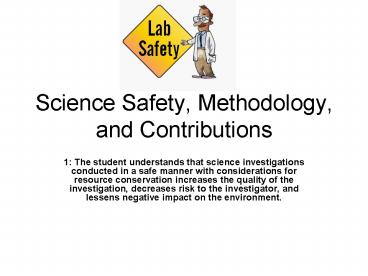Science Safety, Methodology, and Contributions - PowerPoint PPT Presentation
1 / 15
Title:
Science Safety, Methodology, and Contributions
Description:
Science Safety, Methodology, and Contributions. 1: The student understands that ... risk to the investigator, and lessens negative impact on the environment. ... – PowerPoint PPT presentation
Number of Views:31
Avg rating:3.0/5.0
Title: Science Safety, Methodology, and Contributions
1
Science Safety, Methodology, and Contributions
- 1 The student understands that science
investigations conducted in a safe manner with
considerations for resource conservation
increases the quality of the investigation,
decreases risk to the investigator, and lessens
negative impact on the environment.
2
Guiding Questions
- Why should safety be a top priority when
conducting investigations? - Why should we conserve resources when conducting
investigations?
3
Next?
- We will divide into groups of 3.
- One student will fill each of the following
roles - Group Leader
- Group Recorder
- Group Reporter
4
What Next
- Read your article and look at your pictures and
determine the following - What was the accident?
- How did it happen?
- What were the injuries?
- What safety precautions could have prevented or
lessened the effects of the accident?
5
Time to Report!
- Now discuss each incident answering your
questions to the class!
6
So, is safety important?
- If so, who is responsible for lab safety?
7
Who is Responsible for Lab Safety?
8
(No Transcript)
9
Safety Is Everyones ResponsibilityYour
Responsibilities as a student
- 1. Read and study the science activity or
laboratory investigation before coming to class. - Ask questions about the activity before
beginning the exercise. - Identify and understand the hazards and
necessary precautions you need to take. - Understand the concept of the investigation, and
know how to proceed with the investigation.
10
2. Know and follow all safety rules prior to the
first investigation. Read, understand, and sign
the safety contract. Wear the appropriate
protective equipment, such as goggles and
laboratory aprons. Tie back long hair to keep
it away from chemicals, open flames, and
equipment. Tie back or remove articles of
clothing or jewelry that could touch chemicals or
flames during investigations. Wear shoes that
enclose the feetno sandals or open-toe shoes.
Never eat or drink anything while in the
laboratory. Locate the safety equipment, such
as the eye/facewash station, and know how to use
it correctly. Know where the exits are located
and the proper procedures to be followed in an
emergency. Wear splash-proof safety goggles
until all chemicals have been returned, glassware
cleaned, and
11
3. Be alert in the laboratory. Watch for
potential problems, and report unsafe situations
immediately. Do not work alone in the
laboratory. 4. Do not attempt unauthorized
activities. Work only on authorized activities
that are related to the investigation.
12
5. If a chemical spill occurs, report it
immediately and follow the teachers
instructions. Move quickly from the site.
Wash off chemicals that have splashed onto the
skin or clothing for 15 minutes using large
amounts of water in the safety shower or eye/face
wash station
13
6. Keep your area clean
Clean up the area at the end of the class.
Dispose of biological and chemical waste properly
14
7. Do not enter preparatory or equipment storage
rooms or chemical storerooms.
15
8. Always wash your hands for at least.
20 seconds with soap and warm water before
leaving the laboratory































